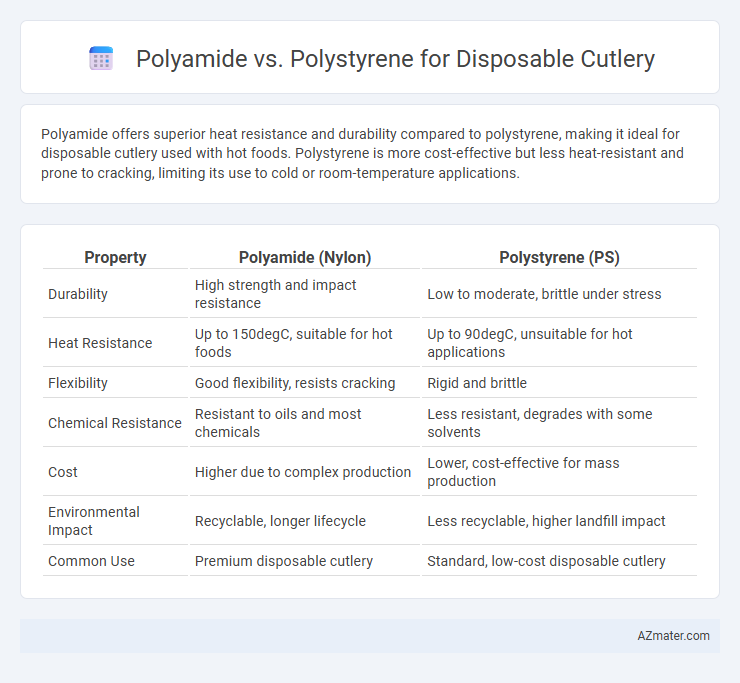Polyamide offers superior heat resistance and durability compared to polystyrene, making it ideal for disposable cutlery used with hot foods. Polystyrene is more cost-effective but less heat-resistant and prone to cracking, limiting its use to cold or room-temperature applications.
Table of Comparison
| Property | Polyamide (Nylon) | Polystyrene (PS) |
|---|---|---|
| Durability | High strength and impact resistance | Low to moderate, brittle under stress |
| Heat Resistance | Up to 150degC, suitable for hot foods | Up to 90degC, unsuitable for hot applications |
| Flexibility | Good flexibility, resists cracking | Rigid and brittle |
| Chemical Resistance | Resistant to oils and most chemicals | Less resistant, degrades with some solvents |
| Cost | Higher due to complex production | Lower, cost-effective for mass production |
| Environmental Impact | Recyclable, longer lifecycle | Less recyclable, higher landfill impact |
| Common Use | Premium disposable cutlery | Standard, low-cost disposable cutlery |
Introduction to Polyamide and Polystyrene Cutlery
Polyamide cutlery, known for its high durability and heat resistance, offers a sustainable alternative to traditional plastics with superior mechanical strength and chemical resistance. Polystyrene cutlery is lightweight, cost-effective, and widely used in disposable applications due to its rigidity and ease of molding, though it is less heat resistant and more prone to cracking. Both materials serve distinct purposes in disposable cutlery, balancing performance, cost, and environmental impact factors.
Material Composition and Properties
Polyamide, a synthetic polymer known for its high strength, flexibility, and resistance to heat and chemicals, offers durability and reusability in disposable cutlery applications. Polystyrene, a rigid, lightweight polymer characterized by its brittleness and lower heat resistance, is commonly used for single-use cutlery due to its cost-effectiveness and ease of molding. The choice between polyamide and polystyrene impacts the cutlery's performance, with polyamide providing enhanced durability and thermal stability, while polystyrene favors economical mass production and lightweight design.
Strength and Durability Comparison
Polyamide exhibits superior strength and durability compared to polystyrene, making it more suitable for disposable cutlery intended for heavy-duty use. Its high tensile strength and resistance to impact ensure that polyamide utensils maintain structural integrity under stress and repeated use. Polystyrene, while cost-effective and lightweight, tends to be brittle and more prone to cracking or breaking, compromising its durability in practical applications.
Heat Resistance Performance
Polyamide exhibits superior heat resistance compared to polystyrene, making it more suitable for disposable cutlery exposed to higher temperatures. While polystyrene typically softens around 100degC, polyamide maintains structural integrity well above 150degC, ensuring durability during hot food consumption. This thermal stability reduces the risk of deformation and potential chemical leaching, enhancing safety and user experience.
Environmental Impact and Biodegradability
Polyamide disposable cutlery, derived from nylon polymers, offers greater durability but poses significant environmental challenges due to its slow biodegradation and persistence in landfills. Polystyrene cutlery, commonly made from petroleum-based foam or plastic, breaks down more quickly in the environment but often releases harmful chemicals and microplastics. The environmental impact of both materials varies widely based on waste management practices, with neither offering a truly sustainable solution compared to biodegradable alternatives such as PLA or cellulose-based utensils.
Safety and Food Compatibility
Polyamide offers superior heat resistance and durability, making it safer for hot food applications compared to polystyrene, which can release harmful chemicals when exposed to high temperatures. Food compatibility of polyamide is enhanced by its inert nature, reducing the risk of contamination and maintaining food taste integrity. Polystyrene's lower melting point and potential for chemical leaching raise concerns about its safety, particularly with acidic or hot foods in disposable cutlery use.
Cost Analysis and Market Availability
Polyamide disposable cutlery typically incurs higher production costs due to its enhanced durability and heat resistance compared to polystyrene, which remains cheaper and widely used in mass-market applications. Polystyrene's extensive market availability stems from established supply chains and lower raw material expenses, making it the preferred choice for budget-conscious manufacturers. Despite higher upfront costs, polyamide cutlery offers a longer lifespan, potentially reducing replacement frequency and overall cost in specialized markets.
User Experience and Comfort
Polyamide cutlery offers superior durability and heat resistance compared to polystyrene, enhancing user comfort by preventing bending and melting during hot food use. Its smooth surface texture provides a more pleasant tactile experience, reducing hand fatigue during extended use. Polystyrene, while cost-effective, tends to be more brittle and less comfortable due to its rigidity and tendency to snap under pressure, negatively impacting overall user satisfaction.
Recycling and Waste Management
Polyamide cutlery, made from nylon polymers, offers higher durability and heat resistance but is less commonly recycled due to limited facilities accepting nylon materials, leading to potential waste management challenges. Polystyrene cutlery, widely employed for its low cost, is recyclable in specialized centers, yet its widespread disposal in general waste streams results in significant environmental pollution and landfill accumulation. Effective recycling programs and material recovery innovations are essential to mitigate the ecological impact of both polyamide and polystyrene disposable cutlery in waste management systems.
Final Verdict: Which is Better for Disposable Cutlery?
Polyamide offers superior heat resistance and durability compared to polystyrene, making it ideal for hot food applications in disposable cutlery. Polystyrene is more cost-effective and lightweight but tends to crack and deform under heat, limiting its use to cold or room temperature foods. For performance and reliability, polyamide is the better choice for disposable cutlery despite a higher price point.

Infographic: Polyamide vs Polystyrene for Disposable Cutlery
 azmater.com
azmater.com